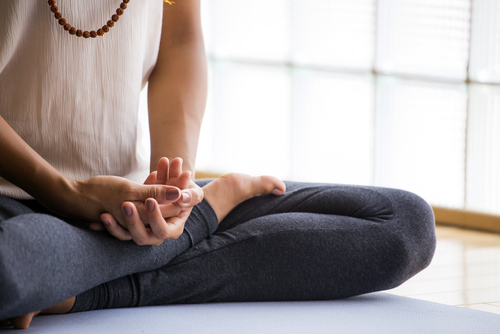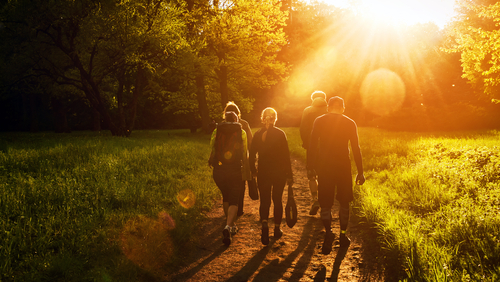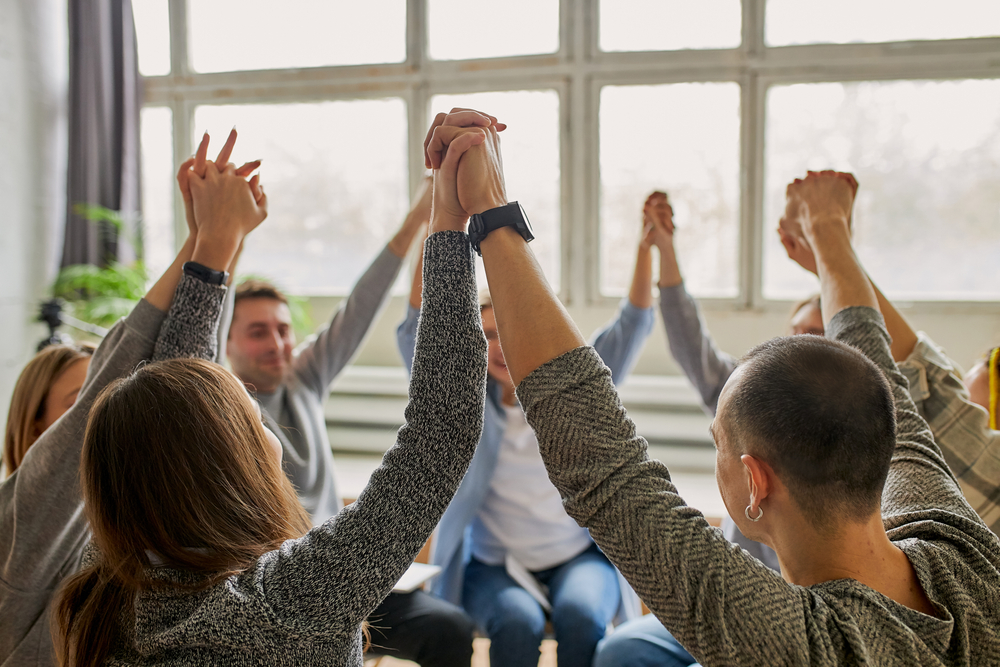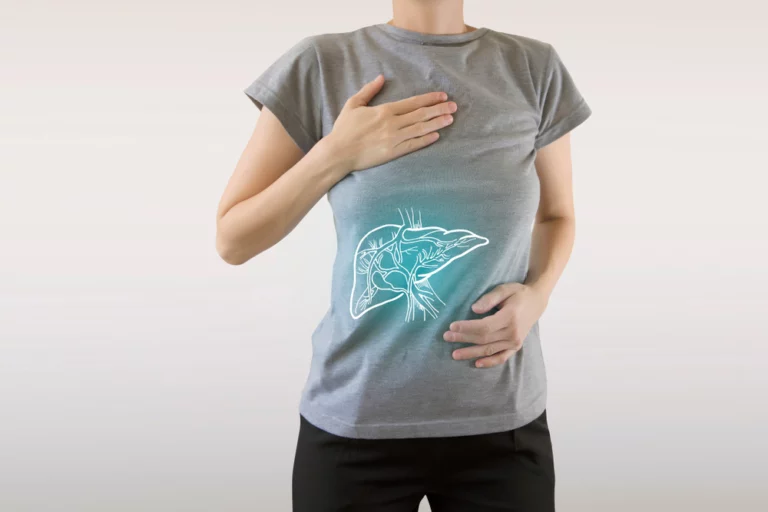15 Mindful Group Activities For Adults in Recovery
Addiction recovery is a lifelong journey. Therefore, upon completing an addiction treatment program, involving yourself in group therapy activities for adults in recovery is crucial to maintaining long-term sobriety.
Mindfulness is cultivating moment-to-moment awareness of thoughts, feelings, and surroundings without judgment. This can be done in many ways, and thousands of exercises have been created to help facilitate this practice. Many group therapy activities include meditation, breathing exercises, body scans, and embodied movement. Other substance abuse group activities focus on the senses: smell, touch, taste, sight, and sound. All mindfulness practices have a common theme: to slow down, drop into our bodies, and witness the experience.
Mindfulness has many health benefits and has been proven to significantly reduce anxiety, stress reactivity, distraction, and depression, all of which can be seen as roadblocks to mental health and substance abuse recovery journeys. Mindfulness based therapy has been clinically proven to increase self-care, focus, cognition, heart and immune system health, rest, stress management, feelings of connection, a sense of belonging, and confidence on the road to well-being.

15 Mindful Group Activities for Adults in Recovery
By practicing mindfulness, individuals with substance use disorders can find healthy coping skills and ground themselves without turning to alcohol, drugs, or other bad habits to relieve anxiety, fear, and depression.
The Raisin Meditation
The group facilitator gives everyone a raisin or a similar food item and asks participants to pretend they’ve never seen a raisin before. This can help to cultivate your ability to be present in the moment, enhance your sensory awareness, and promote a sense of calm and relaxation. The facilitator can then guide them through the following exercises:
- Holding: Hold the raisin in your palm and notice how it feels. Notice its weight and texture.
- Seeing: Gaze at the raisin with your full attention. Imagine you’ve never seen a raisin before or that you will have to produce a drawing from memory. Notice the raisin’s ripples and ridges, color, shadows, and hollows. Notice any imperfections.
- Smelling: Hold the raisin beneath your nose. Inhale and take in any aroma or smell that may arise. As you smell the raisin, also notice if your mouth or stomach reacts to the smell.
- Tasting: Put the raisin in your mouth, but don’t chew. Notice where the raisin needs to be chewed. Then take several conscious bites, and notice the waves of taste. Notice the raisin’s texture as you chew and how it changes.
- Swallow: Before you swallow the raisin, notice if you first detect the intention to swallow and what that feels like. Swallow the raisin and notice if you can continue to feel the raisin as it goes down your throat and moves down into your stomach.
5-4-3-2-1
The 5-4-3-2-1 exercise is helpful for coming back into the present moment, in your body, and getting in touch with your five senses. It goes as follows:
5 – Name 5 things that you can see
4 – Name 4 things that you can feel
3 – Name 3 things that you can hear
2 – Name 2 things that you can smell
1- Name 1 thing that you can taste
Guided Body Scan
Mindful body scans are a great, simple practice for coming back into awareness of the body. They are typically performed while sitting or lying down and can be followed through a guided meditation or on your own. Many mindful body scans are available through guided meditation apps or online. The general format slowly gives awareness to different body parts, often starting with the head and moving down the body until you reach your feet. While doing so, you will scan your body for pain or other sensations, practicing non-judgment, and simply noticing what it feels like.

Mindful Music Therapy
As a group, listen quietly to a song together. Notice the rhythm, song lyrics, instruments, and other details. Notice how it makes you feel. When the song is over, play it once or twice more, and see what you notice in the replays. Then go around and share what you noticed.
Adult Coloring
There are tons of adult coloring books available in stores and online, with all kinds of fun and beautiful themes. Have everyone choose a coloring book page. Decide whether the group would like to all color the same page or if each individual will color a different one. Sit quietly and color together for a while. The Art Therapy group may wish to share their art at the end of the session or discuss how the experience and time spent coloring together felt for them. Check-in questions to the group can include “Did you notice your mind wandering during this activity?” and “Did any frustrations arise?”
Group Meditation
Group meditation is among the most powerful recovery activities for groups. The experience of meditating alongside others can be encouraging, inspiring, and help build social skills and self-esteem. Individuals who have practiced mediation alone may notice a different energy when meditating among others sharing their intentions. Group meditation can also bring challenges, such as navigating distractions from others, such as coughing, sneezing, or sounds from shifting in their seat.
These can all be great opportunities to deepen the practice of coming back to breath after being pulled away. Group meditation may be guided by someone, or it may just be a group of individuals who gather to silently meditate together. Determine the duration of the meditation, and when finished, you all may decide to share your experience or takeaways.
Balancing
Guide the group to take a few deep, slow, grounding breaths before beginning this exercise. Then ask everyone in the group to balance on one foot. Ask them to be aware of the sensations in their foot, ankle, legs, and entire body as they attempt to remain balanced. Ask them to notice any trembling or shaking and to pay attention to the thoughts or possibly fears that come up. Ask them to take a few deep breaths while doing this. After a few minutes, end the exercise and allow everyone to share their experience.
Mindful Seeing
Not everyone is blessed with a lively imagination. For some, the absence of visual stimulation may feel oppressive. Those who are unfamiliar with mindful seeing may benefit from it. To perform the activity, you’ll need a window with a view. The group follows these steps as the facilitator directs them.
- Step 1- Find a window with a pleasant view.
- Step 2- Look at everything in view, and instead of identifying what you see, specifically notice the textures and colors.
- Step 3 – Look at the grass and leaves moving in the wind and notice the various shapes in what you can see. Try to see the world outside from an unfamiliar perspective.
- Step 4- Be observant and aware.
- Step 5- Continue to focus and hold your concentration.
Nature Walk
You and your group can take a nature walk, notice the details as you walk, and pay attention to the sounds of rustling leaves, birds calling, or the wind blowing through the trees. Notice the smells of fir trees, dirt, flowers, and grass, the cool or warm breeze against your skin, and the sights of sunlight filtering through the trees or tiny insects crawling along the path.

Beats Awareness Game
The first person creates a simple beat, and the rest of the group follows suit, repeating the pattern and adding their embellishments. The next player repeats the pattern and adds something new, and the process continues until the individuals before them don’t repeat the pattern. The player who loses must try to distract the other players as they construct and pass on a new beat. The goal is to keep your attention focused on the rhythm and avoid being distracted by anything or anyone. The game is over when only one person is left.
Group Dance
Dance is a great way to practice mindfulness if you enjoy moving. Your muscles are stimulated, your lungs are filled with oxygen, and you inhale and exhale, all as you follow the instructor’s direction and the music. As you become more experienced, you may enjoy seeing yourself and your team dance a favorite routine even more. While you dance, pay attention to your thoughts and feelings as well. They are likely to alter from session to session.
Group Yoga
Millions of people do Yoga every week (and many daily) for a reason. The movements and postures promote restorative breathing, gentle stretching, strength, and flexibility development. Beyond improving the health of the body, our Yoga therapy focuses on calming and healing the mind. If the parts of your being are healthier connected due to yoga, practicing mindfulness will only enhance its effects and accelerate this connection.
Expressive Writing
Journaling is about getting in touch with your experiences through writing, while expressive writing is about processing emotions. The writing exercise allows group members to remember and describe their most meaningful memories. When coping with stressors, group members focus on building confidence and reducing troublesome stress without judging themselves for their feelings. Whether you meet once a day or several times a week, expressive writing as a group will surely boost everybody’s mood. Group members can later challenge their anxious thoughts by living in the moment, remembering to pay attention to the present, and learning how to stay present.
Mindful Gardening
When you think about it, gardening is a type of mindfulness. You can experience harmony, peace, freedom from stress, and pleasure by sowing the seeds. This way, a group can connect with nature and discover a deeper purpose by engaging in meaningful gardening activities. You and other members may spend some time pleasantly working on the garden’s layout, watering, and fertilizing plants. All five of your senses will be engaged as you do relaxing work.
Balloon Play
Playing with balloons isn’t expensive, and it’s great fun. There are several mindful balloon activities, but one of the easiest is the ‘balloon hacky sack.’ To play, you only have to sit in a circle and keep the balloon from touching the ground. This game has no winners or losers, and you may play with more than one balloon at a time. As your group focuses on the balloons and keeping them aloft, your mind will calm down, and all those problems will fade into the background.
Mindfulness-Based Addiction Treatment At Oasis Recovery Center in Asheville, North Carolina
If you or a loved one is interested in group activities for adults in recovery, we can help guide you! Our highly-trained therapeutic and clinical experts at Oasis Recovery offer a safe and comfortable space for clients to undergo addiction treatment. Our medical experts offer a wide range of services and amenities tailored to meet your particular needs. Reach out to our addiction specialists today to learn more about how we can help you navigate the road to recovery.









